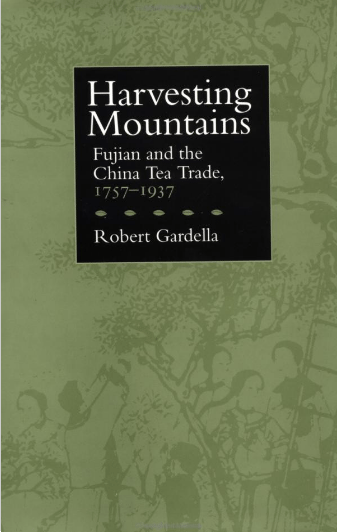 I have been reading this book for a while.
I have been reading this book for a while.
It’s not a long book, it’s just been an ordeal and a half to finish it. I checked it out at the beginning of the semester, read a chapter, and then got caught up in textbook readings, essays, and term projects. But finally, with the end of term, I’ve gotten to sit down with this book again.
Tragically, someone before me felt the need to write all of their notes in the book rather than on paper. It’s only in pencil, and so I thought of erasing it myself if it weren’t so extensive. I got a few dirty looks while reading on the train from people who no-doubt saw the scribbles and pinned me as the culprit.
Harvesting Mountains chronicles the changes the Chinese tea trade underwent following the Opium Wars, focusing on Fujian’s maritime trade. As a contrast, it first sets up the trade in the years directly leading up to the conflict, and then shows how China evolved following the wars, including the rise of Taiwan and Japan as tea exporters with the initial tea boom, and the fall of China tea to India and Sri Lanka as tea exporters.
The book begins with a world view of China’s economy and mindset, with a little bit of the history of production and internal conflicts before summarizing China’s pre-Opium trade with outsiders. Mainly it briefly covers the Canton-centric tea trade of the time, but before that sets up the mid-Qing trade economy as a whole (how pre-Opium tea production compared to grains [paddies], silk, cotton, and salt). It gives you a bit of a better vantage point when Gardella later explores the tea boom from 1842-1888.
I picked this book up for the history, but it is written from an economy/market standpoint, and there is a lot of discussion that went over my head. The book mostly just reminds me of Xavier, since he did read Green Gold, which I specifically put off to read this one first (only to realize there was ANOTHER book on the history of China’s economy, Taxing Heaven’s Storehouse, set even earlier).
Leading up to the Opium Wars, Canton was the only maritime port open to trade with Great Britain and the rest of the far west. To the north, Russia of course had tea trade through Kyakhta. Following the treaty of Nanjing, four more maritime ports were opened to the west. On top of Canton, these included Shanghai, Fuzhou, Amoy and Ningbo. Of these, Fuzhou and Amoy were the most relevant (or at least mentioned the most); as Canton dropped in popularity, Fuzhou became the main trade port. It was faster, much closer to the tea-producing regions, and not as difficult to get to as Canton. Amoy became more prominent mostly as a port dealing in Taiwan’s tea exports.
I wish I had remembered to scan the figures/maps; Gardella spends some time on the initial post-Opium War years as the different ports emerged. He doesn’t go into as much detail on the wars themselves (but that’s for another book).
The tea boom lasted following the conclusion of the first opium war in 1842 until 1888, when Indian and Sri Lankan-grown tea began to dominate the market. This was one of the main reasons I picked up this book–a lot of tea history books approach the rise of India and Sri Lanka/Ceylon as tea producing regions from Britain’s point of view, with the exploits of Robert Fortune, Thomas Lipton and others, but rarely address how this affected China.
The crash caused China to readdress the inefficiencies in their own tea production system, and in a little bit of irony, China ended up sending representatives to India (much more legally than Robert Fortune’s stint) to observe and evaluate their system. This seems to be the start of terrace teas in China, although Gradella doesn’t really say anything to that effect. Keemun/Qimen is picked as the ‘guinea pig’ county for these initial changes in tea production. From here the book mostly tapers off (I like to think this will be where Green Gold picks up, but I haven’t read it yet, so I can’t say).
This is another old hardcover that is pricey as heck, but I think worth picking up if you want a bit of a different perspective on the turn of the century industry, since it’s so commonly summarized more on the western side of things. That said, a cursory google search brought up quite a few results toting pdf downloads, but most of them roundabout, where you have to click through a video or twenty different pages to get to it. Because of that I didn’t really test any of them, because I’m easily spooked by ad-heavy malware-laden websites. But if you want to test your luck, one of them is likely legit, since amazon at least has a chunk of it scanned for preview.
What really interested me was the introduction of Taiwan as a tea producer (which it does focus on quite a bit, since it was, for a time, a part of Fujian); I’d like to find more books specifically on the evolution of Taiwan’s tea market.
- Availability: Amazon, abebooks and ebay both have multiple copies, starting at about $55US .
- Worldcat.org
- And very illegal pdf downloads





30/05/2017 at 12:53 PM
Added to my list of to buy and to read books.
30/05/2017 at 1:45 PM
You might want to add “Taxing Heaven’s Storehouse” too. It covers Sichuan’s tea industry from 1074-1224.
31/05/2017 at 1:38 PM
So much to read and not enough time or money (books in English are not easy to find here).
31/07/2017 at 6:46 AM
And two more books for the long long list :)
About the history of Taiwanese tea: the Taiwanese (English) excellent magazine “the Art of Tea” regularly contains articles about that subject.
04/08/2017 at 10:09 PM
I’ve been able to leaf through a few copies, but last I checked they didn’t sell digital backlogs and I think the physical copies are becoming collectible and expensive…
08/06/2017 at 3:14 PM
A book shouldn’t be an ordeal!
08/06/2017 at 3:30 PM
I still enjoyed the book itself, but sometimes life can make a good book an ordeal.